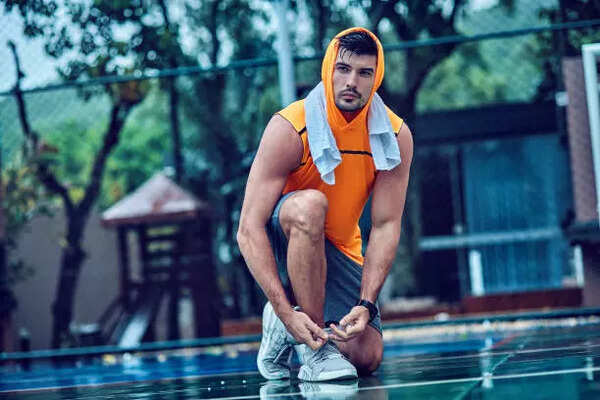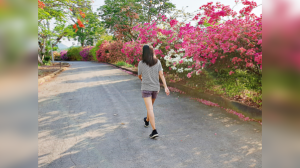Caught in an unexpected downpour? Don't despair. There are several clever tricks to help you dry your clothes faster, even while you're still wearing them. No need for dryers or a change of clothes – just some practical solutions to combat that damp, uncomfortable feeling.

Your first instinct is correct: remove excess water. However, avoid harsh twisting, which can damage the fabric. Instead, gently wring the garment and then pat it dry with an absorbent material.
If you have access to paper towels, napkins, or tissues, place them inside the fabric, especially in areas like underarms, hems, and sleeves. Gently press to absorb the moisture. A hand towel or scarf works even better. The drier the fabric is to begin with, the faster it will air-dry.
Air movement is key. Clothes dry faster when there's a breeze. Standing still in a humid environment will not help.
Walk around, swing your arms, or stretch to create airflow between the wet fabric and your skin. If there's a fan or AC vent nearby, use it. Outdoors, face the wind. The more air that flows through the fabric, the quicker it dries.
Bonus tip: If indoors with a ceiling fan, stand underneath it and extend your arms to expose the sleeves and sides to the air.
It may seem counterintuitive, but layering can help. If you have a jacket, hoodie, or shawl, put it on over your wet clothes. This will shield your skin from the wind and trap body heat, which speeds up evaporation.
Choose a loose outer layer. The goal is to create a warm, insulated space between the wet fabric and the outside air, similar to how a dryer works. However, avoid plastic raincoats, as they can trap moisture.
Public restrooms with hand dryers can be your best friend. These machines can effectively dry soggy sleeves, dripping hems, and damp collars.
Instead of trying to dry a large area at once, focus on the wettest spots individually. Hold the fabric a few inches from the air vent and rotate it slowly. Pay special attention to sleeve cuffs, waistbands, and areas where water tends to collect.
Hair dryers can also work, as well as car vents.
Your body is a portable heater. Use it to your advantage. Constant movement, such as walking or lightly jogging, helps warm air circulate between your skin and the fabric.
Sitting still in wet clothes will only make you colder and slow down the drying process. Stay active. Subtle movements generate body heat that aids evaporation. Gentle stretching or a few minutes of brisk walking can be surprisingly effective.

Getting caught in the rain can be unpleasant, but it doesn't have to ruin your day. With a few simple adjustments and clever use of your surroundings, you can dry your clothes faster than you think.
And if all else fails, embrace the "rain-soaked chic" look.
Newer articles
 Black Caps Announce Packed 2025-26 Home Schedule Featuring Australia, England, West Indies & South Africa
Black Caps Announce Packed 2025-26 Home Schedule Featuring Australia, England, West Indies & South Africa
 Jaiswal Aims to Eclipse Gavaskar's 49-Year-Old Record as India Seeks Series Leveler at Edgbaston
Jaiswal Aims to Eclipse Gavaskar's 49-Year-Old Record as India Seeks Series Leveler at Edgbaston
 Rishabh Pant: Greg Chappell Lauds Indian Star's Game-Changing Cricket Revolution
Rishabh Pant: Greg Chappell Lauds Indian Star's Game-Changing Cricket Revolution
 Samsung Unveils Galaxy A35 5G and A55 5G Pricing, Specs, and Availability
Samsung Unveils Galaxy A35 5G and A55 5G Pricing, Specs, and Availability
 5 Silent Signals: Spotting Prediabetes Without a Blood Test
5 Silent Signals: Spotting Prediabetes Without a Blood Test
 Cummins Lauds Australia's Solid Start in New World Test Championship Campaign
Cummins Lauds Australia's Solid Start in New World Test Championship Campaign
 Science-Backed Strategies: 5 Simple Habits for a Healthier Heart
Science-Backed Strategies: 5 Simple Habits for a Healthier Heart
 The subtext of Gill's selection
The subtext of Gill's selection
 Anish Giri's Jesting Remark Highlights Praggnanandhaa's Rise to Top Junior Chess Ranking
Anish Giri's Jesting Remark Highlights Praggnanandhaa's Rise to Top Junior Chess Ranking
 India vs England: Calls Mount for Kuldeep Yadav's Inclusion in Edgbaston Test Amid Strategic Reworking
India vs England: Calls Mount for Kuldeep Yadav's Inclusion in Edgbaston Test Amid Strategic Reworking